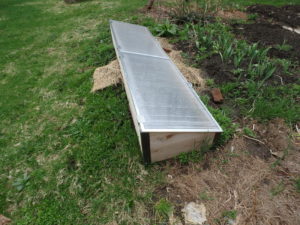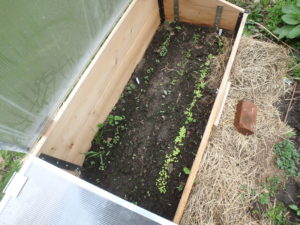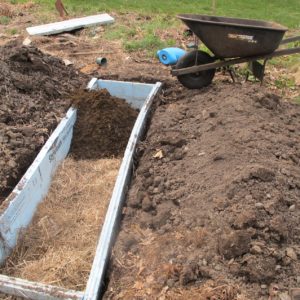Cold Frames and Hot Boxes
I’m ready for spring. I’m ready to start growing – and eating – fresh veggies. Most years I wait until the soil warms up, but this year I planted lettuce, cabbage and spinach in April. I did it in a cold frame, and so far my plants are doing fine – despite some nights in the thirties.
A cold frame is a simple box with a clear slanted top that allow sunshine to come in and warm the soil and plants. The clear top on mine consists of two plexiglass panels on hinges that allow me to open the box on hot sunny days. You can build your own or buy one – mine came from Gardeners Supply (www.gardeners.com) and I was able to assemble it in less than an hour.
My cold frame is eight feet long and two feet wide. The opening lids are lightweight and easy to open. My grandfather had one and he used old wood and glass storm windows. They worked fine, but the glass was susceptible to breakage.
A cold frame should face south or east for maximum solar gain. The cedar panel at the front of mine is 8 inches tall, the back is 15 inches tall. That allows morning sun to get in through the slanted top.
Seeds are designed by Mother Nature to succeed. That means they have safeguards against starting to grow during the January thaw or too early in the spring. Pumpkin seeds in the compost pile, for example, seem to “know” that they shouldn’t start growing until after the danger of frost has passed. They know this because they have a temperature “switch” that prevents germination until the soil warms up so much that frost is unlikely.
So one of the things a cold frame does is warm up the soil. Prior to planting I kept the lids of mine closed, even on hot, sunny days. It is easy to get the air temperature up in the nineties. Once my seeds started growing, I open the lids to allow air to circulate and the temperatures to moderate.
I keep a thermometer in my cold frame that sends a radio signal to a device I keep on the kitchen counter that tells me the current temperature. If I see the temperature approaching 90 degrees, I open the lids. It’s possible to cook tender seedlings if it gets too hot.
Plants grow through series of complex chemical reactions involving energy from the sun, carbon dioxide, oxygen and water. In school you learned that this is called photosynthesis. Other reactions combine amino acids and soil minerals to build proteins and complex carbohydrates.
All these reactions are accelerated by increasing the temperature. Think of a box of tennis balls. The harder you shake the box, the more often they bump into each other. Likewise, warming up molecules makes them move faster and react more quickly – allowing a plant to grow faster.
On a cool, cloudy day my cold frame will heat up 10 or 15 degrees above the ambient temperature outside it. On a chilly night at 40, the temperature inside the box will be close to the temperature outside by morning. If I were to leave the cold frame closed up on a sunny day, it might get 30 or more degrees warmer inside.
One of the uses of my cold frame is as a place to start seeds. My cabbage is up and growing inside mine, but I will move most of them outside before they get too large. Cabbage is relatively cold hardy, even surviving frost. But they need to be 12 to 18 inches apart as they mature. I sprinkled seed in a row inside the box and will thin them to 2 to 3 inches apart now. When they are 2 to 3 inches tall I will move all but one or two outside the box. I’ll have plenty – enough to give some away.
Another protection against cold nights is a layer of Reemay or row cover placed over the seedlings. Reemay and Agribon are trade names of agricultural cloth that breathes and allows sun and moisture to pass through. They can prevent frost from forming on plants down to temperatures of 25 or so – inside the box. It can also be used to keep striped cucumber beetles or other pests off plants.
Last year, my first with this cold frame, used it as a “hot box.” I dug a pit 18 inches deep the size of my cold frame and put a 12-inch layer of fermenting horse manure in the bottom. Then I placed a 6-inch layer of top soil. As the manure fermented it generated heat, warming the soil and keeping the cold frame warm, even on cold nights.
I also lined the hot box pit with 2-inch thick pieces of Styrofoam insulation. That keep the cold soil from cooling down the manure so much that it stops fermenting. That happened to me decade ago with an earlier version, and I had to dig out the manure and start over. It is important to get horse manure that is from a pile that is already hot and fermenting. Too much sawdust or straw will inhibit fermenting.
So I go about my garden, looking for ways to grow things. In another month, I’ll be nibbling on lettuce and other greens. Anything that helps accelerate the process is good!
Read Henry’s twice-weekly blog and see lots of photos at https://dailyuv.com/





